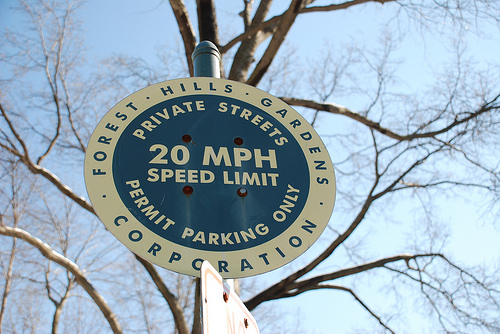How to argue with a traffic engineer about speed limits
It sounds like the beginning of a joke, but it’s actually a valid question: How do you argue effectively with a traffic engineer? For safety-conscious civilians, certain elements of traffic design are especially confusing.

When drivers tend to ignore speed limits, traffic engineers may argue that changing the limit won’t help. Here’s why they may be wrong. From Joe Shlabotnik.
When infrastructure blog Strong Towns recently asked for reader submitted questions, an interesting question came from Adam of Miami, FL, who asked: “How do I argue against a traffic engineer that isn’t interested in the effects on the community of her LOS [level of service], and who believes that posted [speed] limits have no effect?”
Adam explained that he had recently argued with his county’s top traffic engineer, asking why “municipalities are not able to determine their own maximum speed limits on their city streets, less than the default statewide 30mph for residential or commercial districts?” His county, for instance, has narrow streets and “dense foliage” that covers area of the streets — often where are are no sidewalks.
The traffic engineer’s response? That their area’s streets have an 85th percentile of people who currently drive below the street limit — yet not so far below the limit that she would advocate lowering it. As Adam quoted the engineer, “Before and after studies have shown that there is no significant change in prevailing speeds when the speed limit is changed. Drivers will continue to travel at speeds that they feel are safe and prudent, despite the posted limit.”
Strong Towns responded, finding two major faulty beliefs: The first, that drivers will drive at speeds the find “safe and prudent,” and the second, that engineers are not able to influence speed through traffic design. “They design driving lanes with consideration of design speed, but never based on desired speed. They then plead helplessness in influencing how fast people drive,” blogged the site.
(The Strong Towns experts also clarified what 85th percentile speed means. Engineers analyze speeds over a set period in a certain location; that data is reviewed, and the speed limit is the speed which only 15% of drivers exceed. So 85% of drivers are driving at that speed or slower.) While the engineer may be correct in saying that most people drive at the speed limit or lower, “the engineer is not powerless. Safety in this situation is not someone else’s silo.”
It comes down to how the message is conveyed. Signs aren’t the only means of communicating traffic guidelines. “Try driving 20 miles per hour on a highway. It will feel really strange. Everything about a highway from the wide lanes to the wide shoulders to the clear zones and the sweeping curves signal to the driver that is it okay to drive fast,” wrote Strong Towns.
But streets where pedestrians are at risk, where slower driving is key to safety, would also benefit from design cues beyond signs. “You actually need to build the street to communicate the need for a slower speed. That means doing things that are counterintuitive to the traffic engineer,” including: narrowing lanes; using shoulders for parking; street trees and other obstacles that reinforce to drivers the slower-speed environment; and, above all, pedestrians, benches, bike racks, planters and crosswalks that invite human interaction.
The engineer is right, confirmed Strong Towns, in one regard: that people will drive at the speed they find most comfortable. The burden of safety and community building then falls on traffic engineers and urban planners: “You need to demand that your engineer build you a street where drivers feel uncomfortable going more than 20 mph.”
Category: Enforcement, Resources, Road safety

















